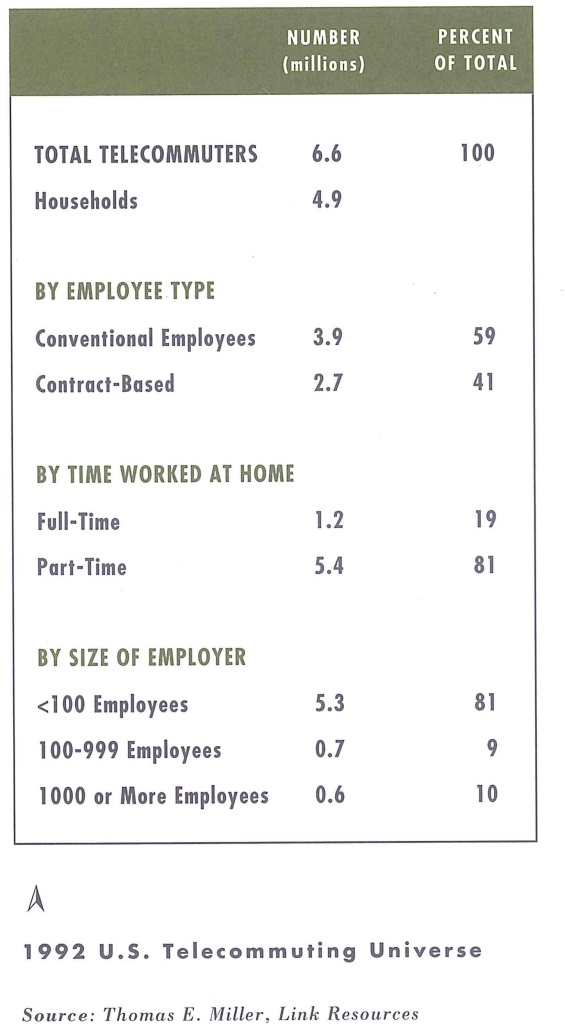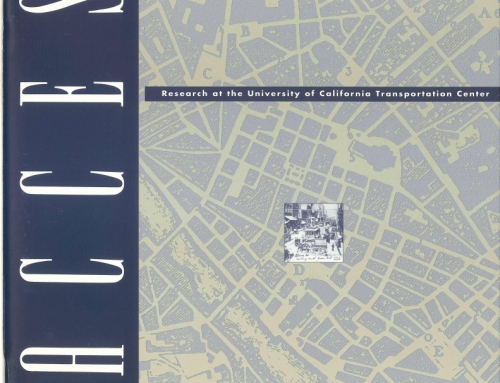Science fiction writers and high-tech enthusiasts may envision a world without commuting. Already, modern telecommunications technology allows people separated by hundreds of miles to work together as if they had adjacent desks. By simply lifting a phone, or switching on a computer modem, we can do our office work from anywhere- even from home. But the convenience telecommuting offers is not problem free.
There’s been so much loose talk about “telecommuting” recently that it’s best we agree on what it means. In this discussion I will refer to telecommuting as working from home, or a location close to home, instead of travelling to a conventional work location. I do not include either after-hours work at home or home-based businesses. Telecommuting might be full time, but it’s more often part time (one or two days a week is typical), and it need not require computers or sophisticated technology. The terms “telework” and “telecommuting” are often used interchangeably, especially outside the United States, but I make a distinction between them: application of telework technologies (such as teleconferencing, fax, cellular phone, and laptop computers) that involve use of telecommunications but do notreplace or modify commute travel does not count as telecommuting.
Telecommuting supporters point to the many potential benefits of their favored work mode:
- reduced travel
- reduced energy consumption
- improved air quality
- better balanced demands of job and family
- reduced costs of health care, reflecting lessened stress and sick leave
- more employment opportunity for mobility-limited and disabled persons
- recruitment and retention of the best workers, regardless of location
- improved availability of services, leading to higher productivity and happier customers
- improved balance between locations of jobs and housing
- increased work brought to underdeveloped regions, boosting their economies
- speedier resumption of business operations, at least partially, after disasters.
While obviously no single public policy can offer a panacea for attaining even one of these ends, telecommuting has indisputably earned a place on the public policy agenda as a potential contributor.
Governmental support for telecommuting has been growing and has taken several forms. The states of California and Washington have formally  authorized telecommuting for government employees, as has the federal government (so far on a pilot basis). The California Department of Transportation and the Washington State Energy Office, among others, have prepared guidebooks and other implementation materials. The California South Coast Air Quality Management District’s Regulation XV and the State of Washington Commute Trip Reduction Ordinance both explicitly recognize telecommuting as a transportation demand-management strategy, the latter assigning a 20 percent “bonus” to trips eliminated through home-based telecommuting.
authorized telecommuting for government employees, as has the federal government (so far on a pilot basis). The California Department of Transportation and the Washington State Energy Office, among others, have prepared guidebooks and other implementation materials. The California South Coast Air Quality Management District’s Regulation XV and the State of Washington Commute Trip Reduction Ordinance both explicitly recognize telecommuting as a transportation demand-management strategy, the latter assigning a 20 percent “bonus” to trips eliminated through home-based telecommuting.
A synergistic relationship has arisen between policy support for telecommuting and its acceptance by employers and workers. Positive evaluations of early demonstration programs lent muscle to the claim that support for telecommuting was desirable public policy. In turn, the increasing body of public policy promoting telecommuting has naturally increased the willingness and ability of executives in both the private and public sectors to adopt it.
Link Resources, a marketing re· search firm, estimates there were approximately 3.9 million telecommuting salaried employees in the United States in 1992, about 3.5 percent of the workforce. (See chart.) Extrapolating from its Annual Work-at-Home Survey, Link Resources believes the number of telecommuters to be increasing at about 20 percent a year. Although current adoption levels are low, the levels seem to be briskly moving upward.
Transportation Effects
At first glance, it seems that telecommuting must certainly reduce travel. However, it’s not necessarily so. We can imagine a number of ways in which telecommuting might increase travel. For example the telecommuter might get “cabin fever” from sitting at home all day and begin to go out on extra “errands,” or another household member might use the telecommuter’s vehicle throughout the day, or telecommuting might create new trips (to the post office, or office supply store, or public fax machine).
Further, vehicle-miles of travel could end up increasing, even while person-miles and numbers of trips decrease. Consider this scenario: a person who used to carpool five days a week now telecommutes three days a week. The carpool breaks up because he and his carpool friends now telecommute, but on different schedules. So, on their non-telecommute days, he and the others drive alone. Fewer person-trips are made, but more vehicle-miles are traveled.
Another possibility: a person who used to live 10 miles from work and drove alone five days a week-traveling 100 miles per week-begins to telecommute. Because she goes to the office only twice a week now, she moves to that cabin in the mountains, 50 miles from work. She now makes sixty percent fewer trips than before, but her weekly commute distance has doubled, to 200 miles.
Well, it’s easy to come up with hypothetical or isolated examples of counterproductive results. The real question is what happens in practice? Are the cases that result in negative outcomes in the majority? Or are these more than compensated for by cases with beneficial effects? The good news is that a number of empirical studies (notably by the State of California and Puget Sound Demonstration Projects) confirm that the bottom-line effects on transportation, energy, and air quality are positive. Specific findings include these:
- Total vehicle-miles of work and non-work travel by telecommuters decline approximately 75 percent on telecommuting days.
- There’s no aggregate increase in non-commute travel.
- Telecommuters make fewer peak-hour trips, having eliminated the work trip (but, interestingly, they continue their peak-hour non-work trips).
- Destinations concentrate closer to home after telecommuting begins on both telecommuting days and regular commuting days.
- Reductions in emissions and fuel use are nearly proportional to reductions in vehicle-miles traveled.
Why Do People Do It, and How Many Will Eventually Do It?
It seems reasonable to believe, then, that telecommuting has positive travel related effects in those specific, small-scale settings in which it is implemented. But recognizing these benefits is only half the battle in determining whether telecommuting is a useful transportation improvement measure. We also must know whether enough people will eventually opt to telecommute to make a significant difference in travel patterns. If telecommuting is unlikely ever to become a mainstream work alternative, then perhaps it is not cost-effective for governments to promote it.

We are now directing our research toward a causal forecast that reflects motivation and payoffs for telecommuting. Our aim is to learn more about why individuals decide whether to telecommute or not, thus to give us an empirical basis for predicting the future scale of telecommuting practice. This knowledge can then be used to investigate the potential consequences for transportation, air quality, and energy consumption.
Currently, most people don’t even have the choice to telecommute. The constraints include lack of awareness, unsuitability of the job, unwillingness of management, technology limitations, and cost. Any long-range, aggregate forecast of the adoption of telecommuting must address the degree to which those constraints are likely to be binding.
On the other hand, there are many people without these constraints, and yet they have not switched to telecommuting. We intend to find out what proportions of people are actively choosing not to telecommute, and why they are making that choice. Learning more about why people do or don’t choose to telecommute will allow us to design policy supporting telecommuting more intelligently.
We are currently analyzing data from about 800 survey respondents (including telecommuters, telecommuter “wanna-bes,” and those with no desire or ability to telecommute). We seek to identify different market segments among the set of potential telecommuters and to describe those segments with demographic and lifestyle variables. Once we find out who are likely to become future telecommuters, the aggregate effect on travel behavior can be estimated more accurately.
Unanswered Questions
So far, telecommuting seems to offer great promise as a transportation improvement strategy. However, many questions remain. Skeptics say we may not even know what we think we know, because findings to date have been based on small, nonrepresentative samples. For example, telecommuters studied so far tend to live two or three times farther from work than do the region’s average employees. Forecasts of transportation savings based on these early adopters are likely to be overstated.
 Another limitation is that currently available findings deal with short-term effects. Long-term outcomes, such as the effects of telecommuting on residential and job locations and on the rates of employment-turnover among telecommuters, have yet to be determined. Further, we don’t yet know enough about why one-time telecommuters return to regular commuting.
Another limitation is that currently available findings deal with short-term effects. Long-term outcomes, such as the effects of telecommuting on residential and job locations and on the rates of employment-turnover among telecommuters, have yet to be determined. Further, we don’t yet know enough about why one-time telecommuters return to regular commuting.
Other concerns surround potential effects of telecommuting on the worker and on family dynamics. What happens to workaholics when their work is always in sight at home? What happens to women trying to do it all when business and home life are combined? What happens when father is at home much of the time, while mother is away at work? What shifts in habits and roles are likely, and what are the potential consequences of those shifts? Telecommuting clearly bears important consequences for more than the conduct of business and the behavior of traffic.
Finally, forecasting the aggregate effects of telecommuting, even just on travel, is complicated by our ignorance of the interactions between telecommunications and transportation. It is possible to have relative substitution of telecommunications for travel, simultaneously with absolute expansions in the volume of both telecommunications and travel. Thus, travel volume might be 5 percent less with telecommuting than it would be without telecommuting (which I think is plausible), but the absolute numbers might continue to increase.
Is a potential “five-percenter” solution worth pursuing? In my opinion it is, for both the travel and the other benefits that telecommuting brings. Many transportation demand management strategies do yield small impacts when taken alone, but a combination of tactics can have an important effect. For telecommuting, it seems that we need to act on what we know today about its positive effects, while continuing to seek answers to the important unknowns, thus improving our capacity to adjust as we learn more. As the revolution in telecommunications runs its course, it seems certain that travel behavior will change as well, and we need to keep ahead of the revolution lest we be overwhelmed by it.
References
Patricia L. Mokhtarian, “Telecommuting and Travel: State of the Practice, State of the Art,” Transportation, Vol. 18 (4), 1991, pp. 319-342. UCTC No. 79.
Patricia L. Mokhtarian, “A Typology of Relationships Between Telecommunications and Transportation,” Transportation Research 24A, No. 3, 1990, pp. 231-242. UCTC No. 82.
Patricia L. Mokhtarian and llan Salomon, “Modeling the Choice of Telecommuting: Setting the Context,” Research Report UCDITS- RR-92-12, March 1993. UCTC No. 147.
Ram M. Pendyala, Konstadinos G. Goulias, and Ryuichi Kitamura, “Impact of Telecommuting on Spatial and Temporal Patterns of Household Travel,” Transportation, Vol. 18, No.4, 1991, pp. 383-409. UCTC No. 111.
Maureen Quaid and Brian Lagerberg, Puget Sound Telecommuting Demonstration Executive Summary, Washington State Energy Office, November 1992.
llan Salomon, “Telecommunications and Travel Relationships: A Review,” Transportation Research 20A , 1986, pp. 223-38.
E . Shirazi, J. Fink, J . Pratt, P. Mokhtarian, G. Gordon, P. Conroy, C. McKeever, D. Carter and E. Schreffler, Telecommuting: A Handbook to Help You Set Up a Program at Your Company, Sacramento: California Department of Transportation, Office of Traffic Improvement, September 1991.






